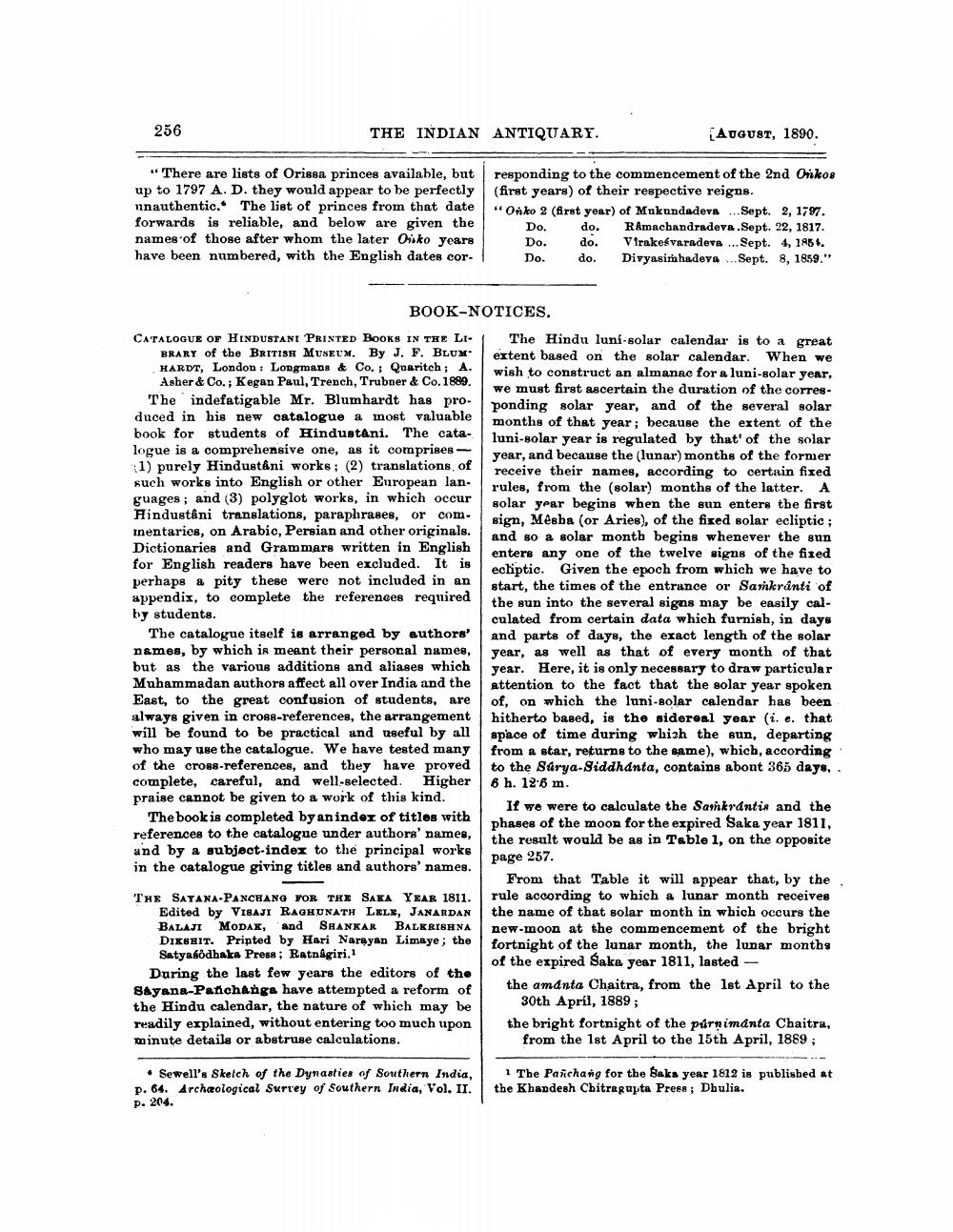________________
256
THE INDIAN ANTIQUARY.
(AUGUST, 1890.
"There are lists of Orissa princes available, but up to 1797 A. D. they would appear to be perfectly unauthentic. The list of princes from that date forwards is reliable, and below are given the names of those after whom the later Omko years have been numbered, with the English dates cor
responding to the commencement of the 2nd Onkos (first years) of their respective reigns. "Onko 2 (first year) of Mukundadeva ...Sept. 2, 1797.
Do. do. Ramachandradeva .Sept. 22, 1817. Do. do. Virakesvaradera ... Sept. 4, 1854.
do. Divyasiri hadeve Sept. 8, 1859."
BOOK-NOTICES.
CATALOGUE OF HINDUSTANI PRINTED BOOKS IN THE LI ! The Hindu luni-solar calendar is to a great BRARY of the BRITISH MUSEUM. By J. F. Blum
extent based on the solar calendar. When we HARDT, London: Longmans & Co.; Quaritch; A.
wish to construct an almanae for a luni-solar year, Asher & Co.; Kegan Paul, Trench, Trubner & Co. 1889.
we must first ascertain the duration of the corresThe indefatigable Mr. Blumhardt has pro
ponding solar year, and of the several solar duced in his new catalogue a most valuable
months of that year; because the extent of the book for students of Hindustani. The cata
luni-solar year is regulated by that' of the solar logue is a comprehensive one, as it comprises -
year, and because the lunar) months of the former 1) purely Hindustani works; (2) translations of
receive their names, according to certain fixed such works into English or other European lan.
rules, from the (solar) months of the latter. A guages; and (3) polyglot works, in which occur
solar year begins when the sun enters the first Hindustani translations, paraphrases, or com.
sign, Mesba (or Aries), of the fixed solar ecliptic; mentaries, on Arabic, Persian and other originals.
and so a solar month begins whenever the sun Dictionaries and Grammars written in English
enters any one of the twelve signs of the fired for English readers have been excluded. It is
echiptic. Given the epoch from which we have to perhaps a pity these were not included in an
start, the times of the entrance or Sankranti of appendix, to complete the references required
the sun into the several signs may be easily calby students.
culated from certain data which furnish, in days The catalogue itself is arranged by authors' and parts of days, the exact length of the solar names, by which is meant their personal names, year, as well as that of every month of that but as the various additions and aliases which year. Here, it is only necessary to draw particular Muhammadan authors affect all over India and the Attention to the fact that the solar year spoken East, to the great confusion of students, are of, on which the luni-solar calendar has been always given in cross-references, the arrangement hitherto based, is the sidereal year (i. e. that will be found to be practical and useful by all space of time during which the sun, departing who may use the catalogue. We have tested many from a star, returns to the same), which, according of the cross-references, and they have proved to the Sarya-Siddhanta, contains abont 365 days, complete, careful, and well-selected Higher 6 h. 12.6 m. praise cannot be given to a work of this kind.
If we were to calculate the Sankrantir and the The book is completed by an index of titles with
phases of the moon for the expired Saka year 1811, references to the catalogue under authors' names,
the result would be as in Table 1, on the opposite and by a subject-index to the principal works
page 257. in the catalogue giving titles and authors' names.
From that Table it will appear that, by the THE SATANA-PANCHANG FOR THE SAKA YEAR 1811. rule according to which a lunar month receives
Edited by VISAJI RAGHUNATH LELE, JANARDAN the name of that solar month in which occurs the BALAJI MODAK, and SHANKAR BALKRISHNA new-moon at the commencement of the bright DIKSHIT. Pripted by Hari Narayan Limaye; the
fortnight of the lunar month, the lunar months Satyabodhaka Press; Ratnagiri.
of the expired Saka year 1811, lasted - During the last few years the editors of the sayana-Panchanga have attempted a reform of
the amanta Chaitra, from the 1st April to the the Hindu calendar, the nature of which may be
30th April, 1889; readily explained, without entering too much upon the bright fortnight of the purnimanta Chaitra, minute details or abstruse calculations.
from the 1st April to the 15th April, 1889;
• Sewell's Sketch of the Dynasties of Southern India, P. 64. Archeological Survey of Southern India, Vol. II. p. 204.
The Panchang for the Baka year 1812 is published at the Khandesh Chitragupta Press; Dhulia.




